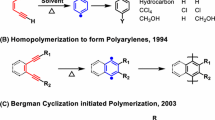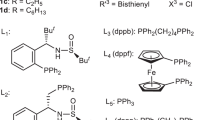Abstract
Green monomers, such as carbon dioxide (CO2), are closely related to our daily life and highly desirable to be transferred to functional polymers with diverse structures and versatile properties because they are abundant, cheap, nontoxic, renewable, and sustainable. However, the polymerizations based on these green monomers are to be further developed. In this work, a facile CO2 and alkyne-based one-pot, two-step, four-component tandem polymerization was successfully established. The polymerization of CO2, diynes, alkyl dihalides, and primary/secondary amines can proceed under mild reaction conditions and regio- and stereoregular poly(aminoacrylate)s with good solubility and thermal stability were obtained in high yields (up to 95%). Notably, distinctly different stereoregularity of resultant poly(aminoacrylate)s was realized via using primary or secondary amines. Using the former would readily generate polymers with 100% Z-isomers, whereas the latter furnished products with over 95% E-isomers. Through different monomer combination, the polymers with tunable structures and properties were obtained. Moreover, the tetraphenylethene units containing poly(aminoacrylate)s, showing the unique aggregation-induced emission characteristics, could function as a fluorescent probe for sensitive explosive detection. Thus, this work not only develops a facile CO2 and alkyne-based multicomponent tandem polymerization but also provides a valuable strategy to fine-tune the polymer structures and properties, which could be potentially applied in diverse areas.
Similar content being viewed by others

References
Hantzsch, A. Ueber die synthese pyridinartiger verbindungen aus acetessigäther und aldehydammoniak. Justus Liebigs Ann. Chem.1882, 215, 1–82.
Mannich, C.; Krosche, W. Ueber ein kondensationsprodukt aus formaldehyd, ammoniak und antipyrin. Arch. Pharm.1912, 250, 647–667.
Passerini, M. Isonitriles. II. Compounds with aldehydes or with ketones and monobasic organic acids. Gazz. Chim. Ital1921, 51, 181–189.
Ugi, I.; Demharter, A.; Hörl, W.; Schmid, T. Ugi reactions with trifunctional α-amino acids, aldehydes, isocyanides and alcohols. Tetrahedron1996, 52, 11657–11664.
Dömling, A.; Ugi, I. Multicomponent reactions with isocyanides. Angew. Chem. Int. Ed.2000, 39, 3168–3210.
Deng, X. X.; Li, L.; Li, Z. L.; Lv, A.; Du, F. S.; Li, Z. C. Sequence regulated poly(ester-amide)s based on Passerini reaction. ACS Macro Lett.2012, 1, 1300–1303.
Lee, I. H.; Kim, H.; Choi, T. L. Cu-catalyzed multicomponent polymerization to synthesize a library of poly(N-sulfonylamidines). J. Am. Chem. Soc.2013, 135, 3760–3763.
Kreye, O.; Tóth, T.; Meier, M. A. Introducing multicomponent reactions to polymer science: Passerini reactions of renewable monomers. J. Am. Chem. Soc.2011, 133, 1790–1792.
Zhang, Z.; You, Y. Z.; Wu, D. C.; Hong, C. Y. Syntheses of sequence-controlled polymers via consecutive multicomponent reactions. Macromolecules2015, 48, 3414–3421.
Hu, R.; Li, W.; Tang, B. Z. Recent advances in alkyne-based multicomponent polymerizations. Macromol. Chem. Phys.2016, 217, 213–224.
Sehlinger, A.; Dannecker, P. K.; Kreye, O.; Meier, M. A. Diversely substituted polyamides: macromolecular design using the Ugi four-component reaction. Macromolecules2014, 47, 2774–2783.
Xue, H.; Zhao, Y.; Wu, H.; Wang, Z.; Yang, B.; Wei, Y.; Wang, Z.; Tao, L. Multicomponent combinatorial polymerization via the Biginelli reaction. J. Am. Chem. Soc.2016, 138, 8690–8693.
Lv, A.; Deng, X. X.; Li, L.; Li, Z. L.; Wang, Y. Z.; Du, F. S.; Li, Z. C. Facile synthesis of multi-block copolymers containing poly(ester-amide) segments with an ordered side group sequence. Polym. Chem.2013, 4, 3659–3662.
Wang, Y. Z.; Deng, X. X.; Li, L.; Li, Z. L.; Du, F. S.; Li, Z. C. One-pot synthesis of polyamides with various functional side groups via Passerini reaction. Polym. Chem.2013, 4, 444–448.
Tuten, B. T.; De Keer, L.; Wiedbrauk, S.; Van Steenberge, P. H.; D’hooge, D. R.; Barner-Kowollik, C. Visible-light-induced Passerini multicomponent polymerization. Angew. Chem. Int. Ed.2019, 58, 5672–5676.
Rotstein, B. H.; Zaretsky, S.; Rai, V.; Yudin, A. K. Small heterocycles in multicomponent reactions. Chem. Rev.2014, 114, 8323–8359.
Estévez, V.; Villacampa, M.; Menéndez, J. C. Recent advances in the synthesis of pyrroles by multicomponent reactions. Chem. Soc. Rev.2014, 43, 4633–4657.
Li, W.; Wu, X.; Zhao, Z.; Qin, A.; Hu, R.; Tang, B. Z. Catalyst-free, atom-economic, multicomponent polymerizations of aromatic diynes, elemental sulfur, and aliphatic diamines toward luminescent polythioamides. Macromolecules2015, 48, 7747–7754.
Tian, T.; Hu, R.; Tang, B. Z. Room temperature one-step conversion from elemental sulfur to functional polythioureas through catalyst-free multicomponent polymerizations. J. Am. Chem. Soc.2018, 140, 6156–6163.
Cao, W.; Dai, F.; Hu, R.; Tang, B. Z. Economic sulfur conversion to functional polythioamides through catalyst-free multicomponent polymerizations of sulfur, acids, and amines. J. Am. Chem. Soc.2020, 142, 978–986.
Zhang, J.; Wang, W.; Liu, Y.; Sun, J. Z.; Qin, A.; Tang, B. Z. Facile polymerization of water and triple-bond based monomers toward functional polyamides. Macromolecules2017, 50, 8554–8561.
Zhang, J.; Shi, W.; Liu, Q.; Chen, T.; Zhou, X.; Yang, C.; Zhang, K..; Xie, Z. Atom-economical, room-temperature, and high-efficiency synthesis of polyamides via a three-component polymerization involving benzoxazines, odorless isocyanides, and water. Polym. Chem.2018, 9, 5566–5571.
Song, B.; Hu, K.; Qin, A.; Tang, B. Z. Oxygen as a crucial comonomer in alkyne-based polymerization toward functional poly(tetrasubstituted furan)s. Macromclecules2018, 51, 7013–7018.
Chen, Z.; Hadjichristidis, N.; Feng, X.; Gnanou, Y. Poly(urethane-carbonate)s from carbon dioxide. Macromolecules2017, 50, 2320–2328.
Song, B.; He, B.; Qin, A.; Tang, B. Z. Direct polymerization of carbon dioxide, diynes, and alkyl dihalides under mild reaction conditions. Macromolecules2018, 51, 42–48.
Fu, W.; Dong, L.; Shi, J.; Tong, B.; Cai, Z.; Zhi, J.; Dong, Y. Multicomponent spiropolymerization of diisocyanides, alkynes and carbon dioxide for constructing 1,6-dioxospiro[4,4]nonane-3,8-diene as structural units under one-pot catalyst-free conditions. Polym. Chem.2018, 9, 5543–5550.
Song, B.; Bai, T.; Xu, X.; Chen, X.; Liu, D.; Guo, J.; Qin, A.; Ling, J.; Tang, B. Z. Multifunctional linear and hyperbranched five-membered cyclic carbonate-based polymers directly generated from CO2 and alkyne-based three-component polymerization. Macromolecules2019, 52, 5546–5554.
Song, B.; Qin, A.; Tang, B. Z. New polymerizations based on green monomer of carbon dioxide. Acta Chim. Sinica2020, 78, 9–22.
Urselmann, D.; Antovic, D.; Müller, T. J. Pseudo five-component synthesis of 2,5-di(hetero)arylthiophenes via a one-pot Sonogashira-Glaser cyclization sequence. Beilstein J. Org. Chem.2011, 7, 1499–1503.
Hong, B. C.; Dange, N. S.; Hsu, C. S.; Liao, J. H. Sequential organocatalytic stetter and michael-aldol condensation reaction: asymmetric synthesis of fully substituted cyclopentenes via a [1+2+2] annulation strategy. Org. Lett.2010, 12, 4812–4815.
McCarroll, A. J.; Walton, J. C. Programming organic molecules: design and management of organic syntheses through free-radical cascade processes. Angew. Chem. Int. Ed.2001, 40, 2225–2248.
Kakuchi, R.; Theato, P. Efficient multicomponent postpolymerization modification based on kabachnik-fields reaction. ACS Macro Lett.2014, 3, 329–332.
He, B.; Su, H.; Bai, T.; Wu, Y.; Li, S.; Gao, M.; Hu, R.; Zhao, Z.; Qin, A.; Ling, J.; Tang, B. Z. Spontaneous amino-yne click polymerization: a powerful tool toward regio-and stereospecific poly(β-aminoacrylate)s. J. Am. Chem. Soc.2017, 139, 5437–5443.
Deng, H.; Hu, R.; Leung, A. C.; Zhao, E.; Lam, J. W.; Tang, B. Z. Construction of regio-and stereoregular poly(enaminone)s by multicomponent tandem polymerizations of diynes, diaroyl chloride and primary amines. Polym. Chem.2015, 6, 4436–4446.
Chen, X.; Bai, T.; Hu, R.; Song, B.; Lu, L.; Ling, J.; Qin, A.; Tang, B. Z. Aroylacetylene-based amino-yne click polymerization toward nitrogen-containing polymers. Macromolecules2020, 53, 2516–2525.
Deng, H.; He, Z.; Lam, J. W.; Tang, B. Z. Regio- and stereoselective construction of stimuli-responsive macromolecules by a sequential coupling-hydroamination polymerization route. Polym. Chem.2015, 6, 8297–8305.
Qiu, Z.; Hao, B.; Gu, X.; Wang, Z.; Xie, N.; Lam, J. W.; Hao, H.; Tang, B. Z. A general powder dusting method for latent fingerprint development based on AIEgens. Sci. China Chem.2018, 61, 966–970.
Yang, J.; Chi, Z.; Zhu, W.; Tang, B. Z.; Li, Z. Aggregation-induced emission: a coming-of-age ceremony at the age of eighteen. Sci. China Chem.2019, 62, 1090–1098.
De Nisi, F.; Francischello, R.; Battisti, A.; Panniello, A.; Fanizza, E.; Striccoli, M.; Gu, X.; Leung, N. L. C.; Tang, B. Z.; Pucci, A. Red-emitting AIEgen for luminescent solar concentrators. Mater. Chem. Front.2017, 1, 1406–1412.
Feng, G.; Liu, B. Aggregation-induced emission (AIE) dots: emerging theranostic nanolights. Acc. Chem. Res.2018, 51, 1404–1414.
Yang, J.; Zhen, X.; Wang, B.; Gao, X.; Ren, Z.; Wang, J.; Xie, Y.; Li, J.; Peng, Q.; Pu, K.; Li, Z. The influence of the molecular packing on the room temperature phosphorescence of purely organic luminogens. Nat. Commun.2018, 9, 840.
Salinas, Y.; Martínez-Máñez, R.; Marcos, M. D.; Sancenón, F.; Costero, A. M.; Parra, M.; Gil, S. Optical chemosensors and reagents to detect explosives. Chem. Soc. Rev.2012, 41, 1261–1296.
Wu, Y.; Qin, A.; Tang, B. Z. AIE-active polymers for explosive detection. Chinese J. Polym. Sci.2017, 35, 141–154.
Ma, H.; He, C.; Li, X.; Ablikim, O.; Zhang, S.; Zhang, M. A fluorescent probe for TNP detection in aqueous solution based on joint properties of intramolecular charge transfer and aggregation-induced enhanced emission. Sensor Actuat. B-Chem.2016, 230, 746–752.
Ma, Y.; Li, H.; Peng, S.; Wang, L. Highly selective and sensitive fluorescent paper sensor for nitroaromatic explosive detection. Anal. Chem.2012, 84, 8415–8421.
Pinrat, O.; Boonkitpatarakul, K.; Paisuwan, W.; Sukwattanasinitt, M.; Ajavakom, A. Glucopyranosyl-1,4-dihydropyridine as a new fluorescent chemosensor for selective detection of 2,4,6-trinitrophenol. Analyst2015, 140, 1886–1893.
Acknowledgments
This work was financially supported by the National Natural Science Foundation of China (Nos. 21788102, 21525417, and 21490571), the Natural Science Foundation of Guangdong Province (Nos. 2016A030312002 and 2019B030301003), and the Innovation and Technology Commission of Hong Kong (ITC-CNERC14S01).
Author information
Authors and Affiliations
Corresponding authors
Electronic Supplementary Information
10118_2020_2454_MOESM1_ESM.pdf
Green Monomer of CO2 and Alkyne-based Four-component Tandem Polymerization toward Regio- and Stereoregular Poly(aminoacrylate)s
Rights and permissions
About this article
Cite this article
Song, B., Qin, AJ. & Tang, B.Z. Green Monomer of CO2 and Alkyne-based Four-component Tandem Polymerization toward Regio- and Stereoregular Poly(aminoacrylate)s. Chin J Polym Sci 39, 51–59 (2021). https://doi.org/10.1007/s10118-020-2454-2
Received:
Accepted:
Published:
Issue Date:
DOI: https://doi.org/10.1007/s10118-020-2454-2



